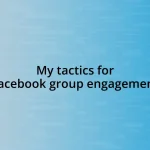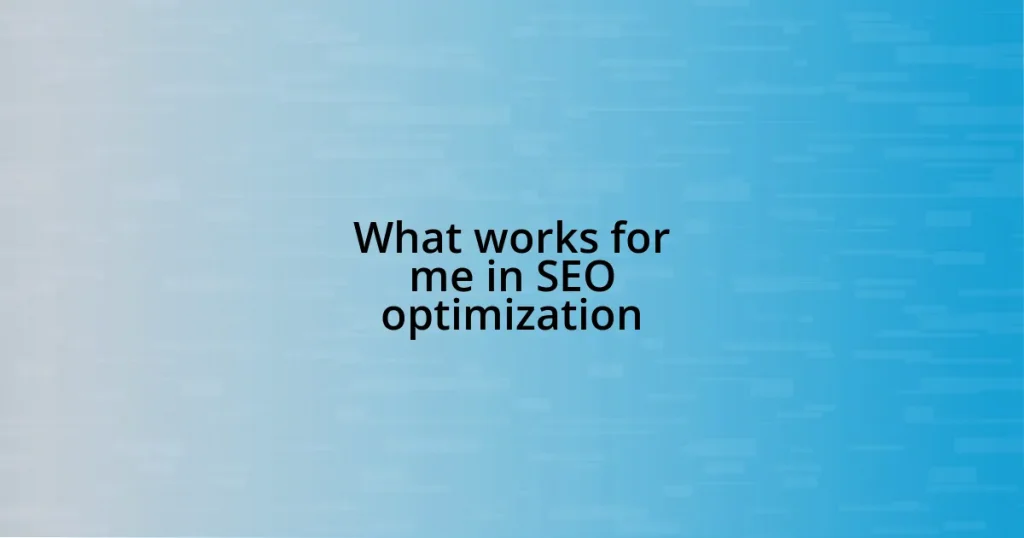Key takeaways:
- Emotional connections are fostered through vulnerability, authenticity, and shared experiences, which encourage openness among individuals.
- Understanding audience needs through direct feedback and empathy enhances content relevancy and engagement.
- Crafting relatable stories and using effective body language strengthen emotional bonds and make communication more engaging.
- Measuring emotional impact relies on qualitative feedback, highlighting the importance of personal connections over mere metrics.

Understanding Emotional Connection
Emotional connection thrives on vulnerability and authenticity. I remember a time when I shared a personal struggle in a discussion group; the response was overwhelming. It was a simple confession about feeling lost in my career, yet it sparked a profound connection with others who had walked a similar path. Have you ever noticed how sharing your true self invites others to do the same?
Creating that bond often means tapping into shared experiences and emotions. There’s a moment in any conversation where you can feel the energy shift—when someone’s eyes widen in recognition of a feeling they thought was unique to them. I cherish those moments because they’re reminders that we are all navigating similar challenges. What do you think happens when someone realizes they’re not alone in their struggles?
Lastly, understanding emotional connection requires empathy. When I listen to a friend share a challenge, I strive to put myself in their shoes, feeling their joys and pains. It’s when I actively engage with their emotions that I can truly connect. How do you respond when someone opens up to you?

Identifying Your Audience Needs
Identifying your audience’s needs is crucial for creating content that resonates deeply. I often find that tuning into their questions and concerns helps reveal what’s on their minds. For instance, the time I asked my audience for feedback on a blog post, the responses unveiled not only their interests but also their struggles, reinforcing the idea that creating a dialogue can uncover hidden needs.
Understanding the demographics of your audience can also guide your approach. When I looked into the age, location, and lifestyle factors of my readers, it became clear that a younger audience craved more interactive content, while older readers preferred in-depth analysis. This kind of insight sharpened my focus and allowed me to tailor my messaging to their preferences, fostering a stronger connection.
Sometimes, it’s not just about data but about empathy and active listening. I remember attending a workshop where we broke into small groups to share our challenges. The range of emotions expressed was profound, painting a vivid picture of unmet needs across various individuals. By reflecting on those conversations, I learned to address these needs in my work, as true understanding often arises from shared stories and experiences.
| Aspect | Example |
|---|---|
| Direct Feedback | Surveys and comments reveal needs |
| Demographics | Adjusting content for age groups |
| Empathy | Listening to shared experiences |

Crafting Relatable Stories
Crafting relatable stories is a powerful way to forge emotional connections. I recall a particularly heartfelt post I wrote about my experience losing a loved one. The response was immense; readers reached out to share their own stories of grief. It’s as if my vulnerability acted as a beacon, drawing in those who had endured similar pain. The beauty of storytelling lies in how it transcends individual experiences, reminding us that we’re part of something greater.
Here are some tips for developing relatable stories:
- Be Authentic: Share your genuine feelings and experiences, no matter how messy they may seem.
- Use Specific Details: I find that incorporating vivid imagery helps paint relatable pictures. Describing the way the sun felt on my skin during a poignant moment made my story vivid and engaging.
- Encourage Interaction: End with an open question that invites your audience to share their experiences, deepening the connection and sparking dialogue.
By weaving in these elements, I aim to create stories that resonate and linger in the hearts of my audience.

Using Body Language Effectively
Using body language effectively can truly transform the way I connect with my audience. For instance, when I speak in front of a crowd, I consciously position myself to face them fully, as it fosters a sense of trust and openness. There’s a certain warmth that emanates when I maintain eye contact; it feels like I’m genuinely inviting them into the conversation.
I’ve also learned the power of gestures. One time, while presenting a complicated idea, I used my hands to illustrate the concept visually. This not only clarified my points but also made the audience feel like they were part of the process. It’s fascinating how non-verbal cues can reinforce my message, making it more compelling and relatable.
Moreover, my posture plays a significant role in how my audience perceives me. Standing tall and relaxed signals confidence, inviting engagement from the crowd. Conversely, I find that when I slouch or cross my arms, it can create a barrier, making the connection feel distant. Have you ever noticed how your own body language shifts in different settings? Being mindful of this not only enhances my delivery but also deeply resonates with those I’m communicating with, paving the way for a stronger emotional bond.

Engaging Through Authentic Vulnerability
Sharing my struggles openly has always been a game-changer in connecting with my audience. I remember a time when I discussed my battle with self-doubt in a podcast episode. The flood of messages I received afterward reminded me how many people are grappling with similar feelings. It’s incredibly powerful to realize that by showing my own vulnerabilities, I create a safe space for others to voice their insecurities and stories.
When I allow my authentic self to shine through my imperfections, it sparks a deeper connection. For instance, I once shared a moment when I faced failure in an important project. I detailed my feelings of disappointment and how I picked myself up. The response was overwhelming; many listeners reached out to share instances of their own failures with a renewed sense of solidarity. This interaction not only humanized my experience but also highlighted how vulnerability acts as a bridge between us, fostering empathy and understanding.
I often wonder, why do we shy away from sharing our authentic selves? It’s something I grapple with continuously. However, I’ve learned that embracing my vulnerabilities opens the door to genuine conversations that resonate. Each time I take that leap, I’m reminded that we’re all in this together, navigating our ups and downs while supporting one another. Isn’t it incredible how much strength can be found in vulnerability?

Creating Interactive Experiences
Creating interactive experiences is all about inviting my audience to participate in the conversation. For instance, during a recent workshop, I encouraged everyone to share their thoughts on a topic we were discussing. This simple act transformed the session; it wasn’t just me talking at them but rather a dynamic exchange of ideas. I find that when people share their perspectives, they become more invested in the discussion. Have you ever noticed how sharing a personal story makes a group feel more connected? It’s amazing to witness the shift in energy when audiences realize they have a voice in the dialogue.
I also enjoy incorporating real-time polls or quizzes to gauge the audience’s reactions. Just the other day, while presenting at a conference, I used an interactive tool to ask my audience about their biggest challenges in our field. The responses were instantaneous and insightful, sparking engaging discussions that I didn’t initially plan. It was a delightful surprise to see how the audience’s input could shape the direction of my presentation. I believe that such interactive elements not only keep everyone alert but also make them feel valued. Isn’t it curious how a simple question can unlock a treasure trove of insights?
Then there’s the art of storytelling—an element I often weave into my presentations. Instead of dry statistics, I love sharing relatable anecdotes that evoke laughter or empathy. One memorable moment was when I shared a clumsy incident from my early days in the industry. The collective chuckle that erupted helped break the ice, creating a relaxed atmosphere where everyone felt comfortable to engage. I truly believe that when I connect on an emotional level through stories, we build a sense of community that makes the entire experience richer and more enjoyable. Have you felt that same sense of camaraderie in your own interactions? It’s moments like these that I treasure most.

Measuring Emotional Impact
Measuring the emotional impact of my content can sometimes feel like an art rather than a science. One memorable moment stands out; after a webinar I hosted on mental health, a viewer sent me a heartfelt message about how my words had resonated with her struggles. That moment reminded me that emotional responses are often rooted in personal experiences that go beyond numbers or metrics.
To truly gauge emotional impact, I often look at responses in various forms—comments, messages, and even social media shares. One time, I was taken aback when a listener quoted one of my podcast episodes in a personal blog post, explaining how it prompted her to seek therapy. That type of feedback gives me profound insights into how my message has affected someone on a deeper level. It makes me wonder, how can we measure the intangible?
I’ve learned that emotional engagement isn’t solely about liking or viewing numbers; it’s about fostering a sense of belonging. During an online session where I invited participants to share their own stories, one participant opened up about losing a loved one. The authenticity of her experience enriched the conversation, creating bonds among us that were tangible. It’s moments like these that truly illuminate the emotional impact of my work. How often do we stop to reflect on the ripple effect our words can create?















